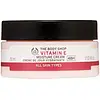What's inside
What's inside
 Key Ingredients
Key Ingredients

 Benefits
Benefits

 Concerns
Concerns

 Ingredients Side-by-side
Ingredients Side-by-side

Water
Skin ConditioningIsopropyl Palmitate
EmollientGlycerin
HumectantButylene Glycol
HumectantCetyl Alcohol
EmollientGlyceryl Stearate
EmollientPEG-100 Stearate
Cetyl Esters
EmollientMyristyl Myristate
EmollientPhenoxyethanol
PreservativeCaprylyl Glycol
EmollientTocopheryl Acetate
AntioxidantCarbomer
Emulsion StabilisingRubus Idaeus Seed Oil
EmollientParfum
MaskingSodium Stearoyl Glutamate
CleansingTrisodium Ethylenediamine Disuccinate
Sodium Hydroxide
BufferingSodium Hyaluronate
HumectantBenzyl Benzoate
AntimicrobialBenzyl Alcohol
PerfumingGeraniol
PerfumingLinalool
PerfumingLimonene
PerfumingHydroxycitronellal
PerfumingAlpha-Isomethyl Ionone
PerfumingCI 14700
Cosmetic ColorantCI 19140
Cosmetic ColorantWater, Isopropyl Palmitate, Glycerin, Butylene Glycol, Cetyl Alcohol, Glyceryl Stearate, PEG-100 Stearate, Cetyl Esters, Myristyl Myristate, Phenoxyethanol, Caprylyl Glycol, Tocopheryl Acetate, Carbomer, Rubus Idaeus Seed Oil, Parfum, Sodium Stearoyl Glutamate, Trisodium Ethylenediamine Disuccinate, Sodium Hydroxide, Sodium Hyaluronate, Benzyl Benzoate, Benzyl Alcohol, Geraniol, Linalool, Limonene, Hydroxycitronellal, Alpha-Isomethyl Ionone, CI 14700, CI 19140
Water
Skin ConditioningCetearyl Alcohol
EmollientKaolin
AbrasiveHydrated Silica
AbrasiveGlycerin
HumectantStearic Acid
CleansingCaprylic/Capric Triglyceride
MaskingButyrospermum Parkii Butter
Skin ConditioningParfum
MaskingCocos Nucifera Oil
MaskingBambusa Arundinacea Stem Extract
Skin ConditioningZiziphus Jujuba Fruit Extract
Skin ConditioningNelumbo Nucifera Flower Extract
Skin ConditioningBisabolol
MaskingEthylhexylglycerin
Skin ConditioningTocopherol
AntioxidantDisodium EDTA
Xanthan Gum
EmulsifyingSodium Cetearyl Sulfate
CleansingSodium Stearoyl Glutamate
CleansingSodium Stearoyl Lactylate
EmulsifyingPolyacrylamide
Water, Cetearyl Alcohol, Kaolin, Hydrated Silica, Glycerin, Stearic Acid, Caprylic/Capric Triglyceride, Butyrospermum Parkii Butter, Parfum, Cocos Nucifera Oil, Bambusa Arundinacea Stem Extract, Ziziphus Jujuba Fruit Extract, Nelumbo Nucifera Flower Extract, Bisabolol, Ethylhexylglycerin, Tocopherol, Disodium EDTA, Xanthan Gum, Sodium Cetearyl Sulfate, Sodium Stearoyl Glutamate, Sodium Stearoyl Lactylate, Polyacrylamide
 Reviews
Reviews

Ingredients Explained
These ingredients are found in both products.
Ingredients higher up in an ingredient list are typically present in a larger amount.
Glycerin is already naturally found in your skin. It helps moisturize and protect your skin.
A study from 2016 found glycerin to be more effective as a humectant than AHAs and hyaluronic acid.
As a humectant, it helps the skin stay hydrated by pulling moisture to your skin. The low molecular weight of glycerin allows it to pull moisture into the deeper layers of your skin.
Hydrated skin improves your skin barrier; Your skin barrier helps protect against irritants and bacteria.
Glycerin has also been found to have antimicrobial and antiviral properties. Due to these properties, glycerin is often used in wound and burn treatments.
In cosmetics, glycerin is usually derived from plants such as soybean or palm. However, it can also be sourced from animals, such as tallow or animal fat.
This ingredient is organic, colorless, odorless, and non-toxic.
Glycerin is the name for this ingredient in American English. British English uses Glycerol/Glycerine.
Learn more about GlycerinParfum is a catch-all term for an ingredient or more that is used to give a scent to products.
Also called "fragrance", this ingredient can be a blend of hundreds of chemicals or plant oils. This means every product with "fragrance" or "parfum" in the ingredients list is a different mixture.
For instance, Habanolide is a proprietary trade name for a specific aroma chemical. When used as a fragrance ingredient in cosmetics, most aroma chemicals fall under the broad labeling category of “FRAGRANCE” or “PARFUM” according to EU and US regulations.
The term 'parfum' or 'fragrance' is not regulated in many countries. In many cases, it is up to the brand to define this term.
For instance, many brands choose to label themselves as "fragrance-free" because they are not using synthetic fragrances. However, their products may still contain ingredients such as essential oils that are considered a fragrance by INCI standards.
One example is Calendula flower extract. Calendula is an essential oil that still imparts a scent or 'fragrance'.
Depending on the blend, the ingredients in the mixture can cause allergies and sensitivities on the skin. Some ingredients that are known EU allergens include linalool and citronellol.
Parfum can also be used to mask or cover an unpleasant scent.
The bottom line is: not all fragrances/parfum/ingredients are created equally. If you are worried about fragrances, we recommend taking a closer look at an ingredient. And of course, we always recommend speaking with a professional.
Learn more about ParfumSodium Stearoyl Glutamate is an emulsifier and helps condition the skin. It is amino acid-based.
In higher amounts, it may act as a cleansing agent.
Water. It's the most common cosmetic ingredient of all. You'll usually see it at the top of ingredient lists, meaning that it makes up the largest part of the product.
So why is it so popular? Water most often acts as a solvent - this means that it helps dissolve other ingredients into the formulation.
You'll also recognize water as that liquid we all need to stay alive. If you see this, drink a glass of water. Stay hydrated!
Learn more about Water